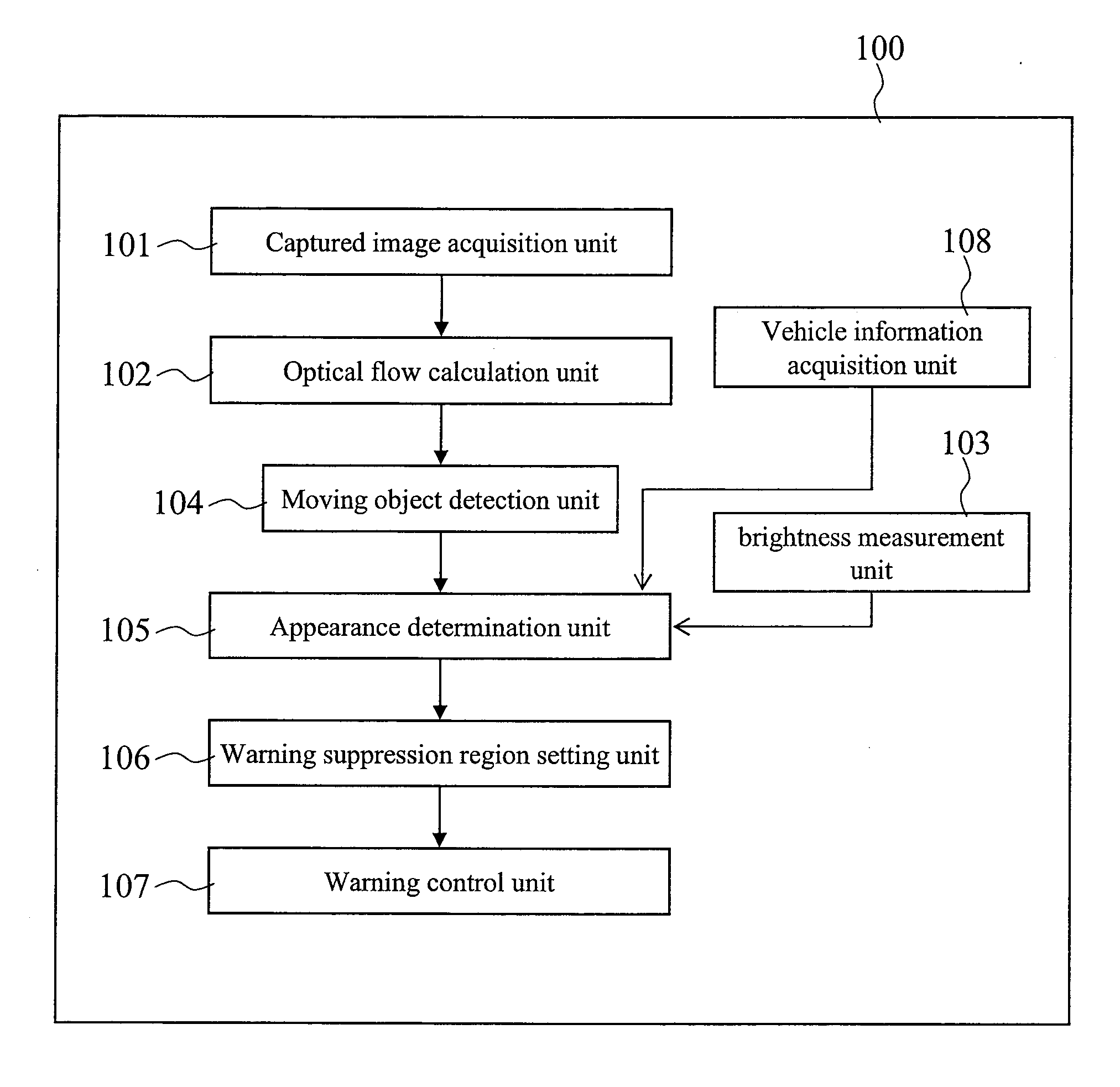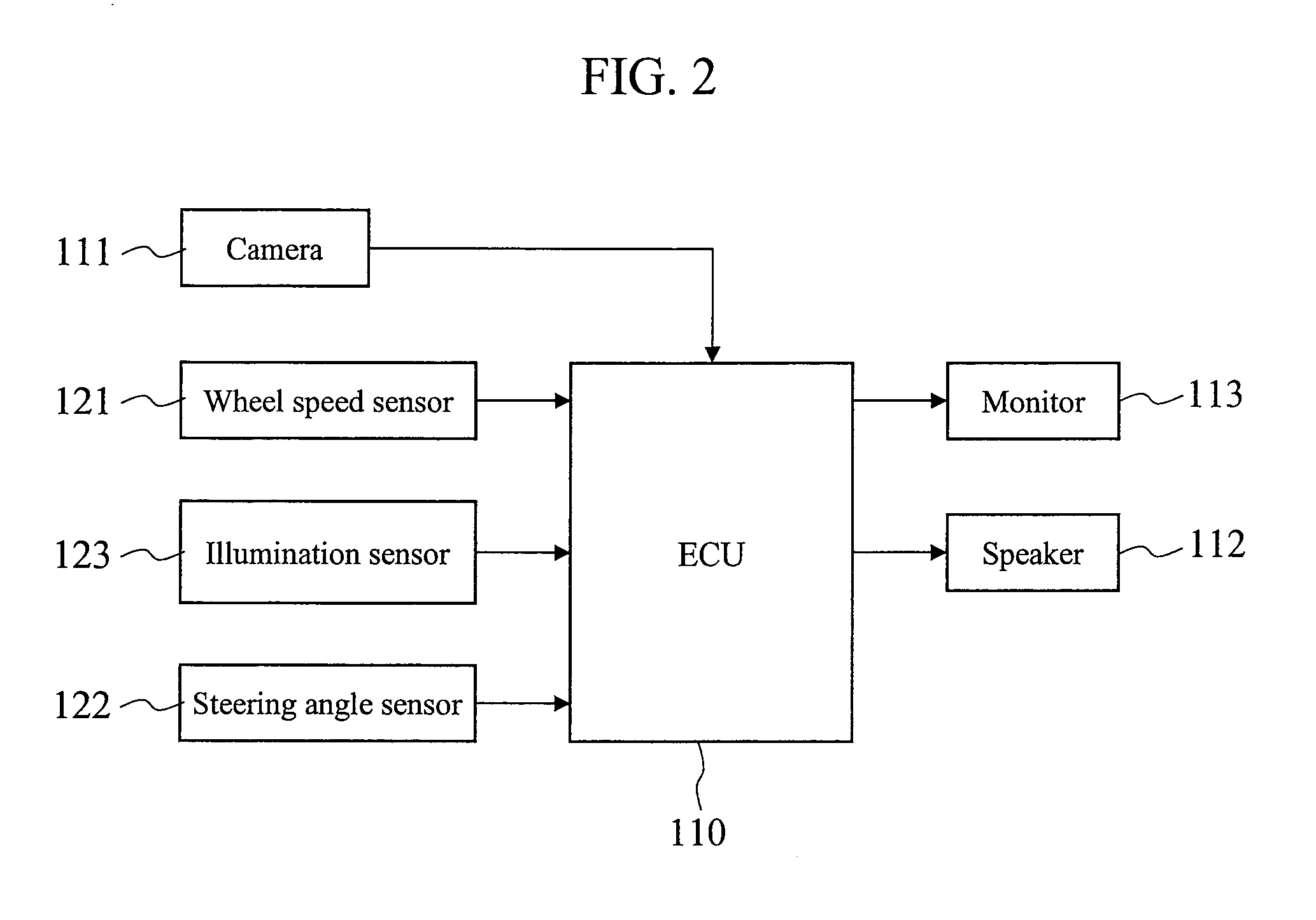Vehicle Peripheral Area Observation System
a technology of observation system and vehicle, which is applied in the field of vehicle peripheral area observation system, can solve the problems of erroneous optical flow detection, erroneous optical flow measurement, and inability to detect the presence of another vehicle accurately and easily
- Summary
- Abstract
- Description
- Claims
- Application Information
AI Technical Summary
Benefits of technology
Problems solved by technology
Method used
Image
Examples
first embodiment
[0027]Hereinafter, a first embodiment will be described.
[0028]A primary object of a vehicle peripheral area observation system in accordance with this embodiment is to provide a user-friendly vehicle peripheral area observation system that, by detecting a region of an apparent motion due to water vapor or a light source fluctuation, invalidates a result of detection of a moving object in the region and suppresses error warnings that would otherwise be output due to the apparent motion.
[0029]The vehicle peripheral area observation system, in order to detect a moving object around a vehicle, calculates optical flows between images captured with an on-vehicle camera at preset time intervals, and if a given number or more of pixels having flows in an identical direction aggregate, outputs information on the pixels as a moving object.
[0030]Water vapor that can be a cause of an error warning has the following characteristics (1) to (5): (1) the contrast is low in the daytime; (2) when the...
embodiment 1
[0039]Next, an embodiment of a vehicle peripheral area observation system 100 will be described with reference to the drawings. This embodiment concerns the vehicle peripheral area observation system 100 in which an image of the peripheral area of a vehicle is captured with an on-vehicle camera 111, and, when a moving object that has a possibility of hitting against the vehicle 120 is detected, a warning is output.
[0040]First, terms used in the following description will be defined. A motion vector representing the amount of movement between image coordinates calculated from two images, which have been captured with an imaging device at different time points, will be referred to as an optical flow.
[0041]There are cases where, even when an object has not actually moved, optical flows are calculated as the shape of the object changes from moment to moment like water vapor. There are also cases where, when a light source illumination environment of a vehicle, another vehicle, or an obj...
second embodiment
[0115]Next, a second embodiment will be described with reference to FIG. 11.
[0116]An overall flow of a process in this embodiment is substantially the same as that in the first embodiment. Thus, only portions that differ from those in the first embodiment will be described. FIG. 11 is a diagram illustrating a hardware configuration of the second embodiment.
[0117]In the second embodiment, a configuration is provided in which a video correction unit 165 receives a video from the camera 161. The video correction unit 165 performs overhead view conversion on each of videos from cameras mounted on the front, rear, right, and left of the vehicle to merge the videos, thereby generating an overhead view monitor image. The video correction unit 165 then transmits a video including the thus generated overhead view monitor image to the CPU 160. The CPU 160 detects an apparent motion or detects a moving object.
[0118]Detection of an apparent motion from the overhead view monitor image is substan...
PUM
 Login to View More
Login to View More Abstract
Description
Claims
Application Information
 Login to View More
Login to View More - R&D
- Intellectual Property
- Life Sciences
- Materials
- Tech Scout
- Unparalleled Data Quality
- Higher Quality Content
- 60% Fewer Hallucinations
Browse by: Latest US Patents, China's latest patents, Technical Efficacy Thesaurus, Application Domain, Technology Topic, Popular Technical Reports.
© 2025 PatSnap. All rights reserved.Legal|Privacy policy|Modern Slavery Act Transparency Statement|Sitemap|About US| Contact US: help@patsnap.com



